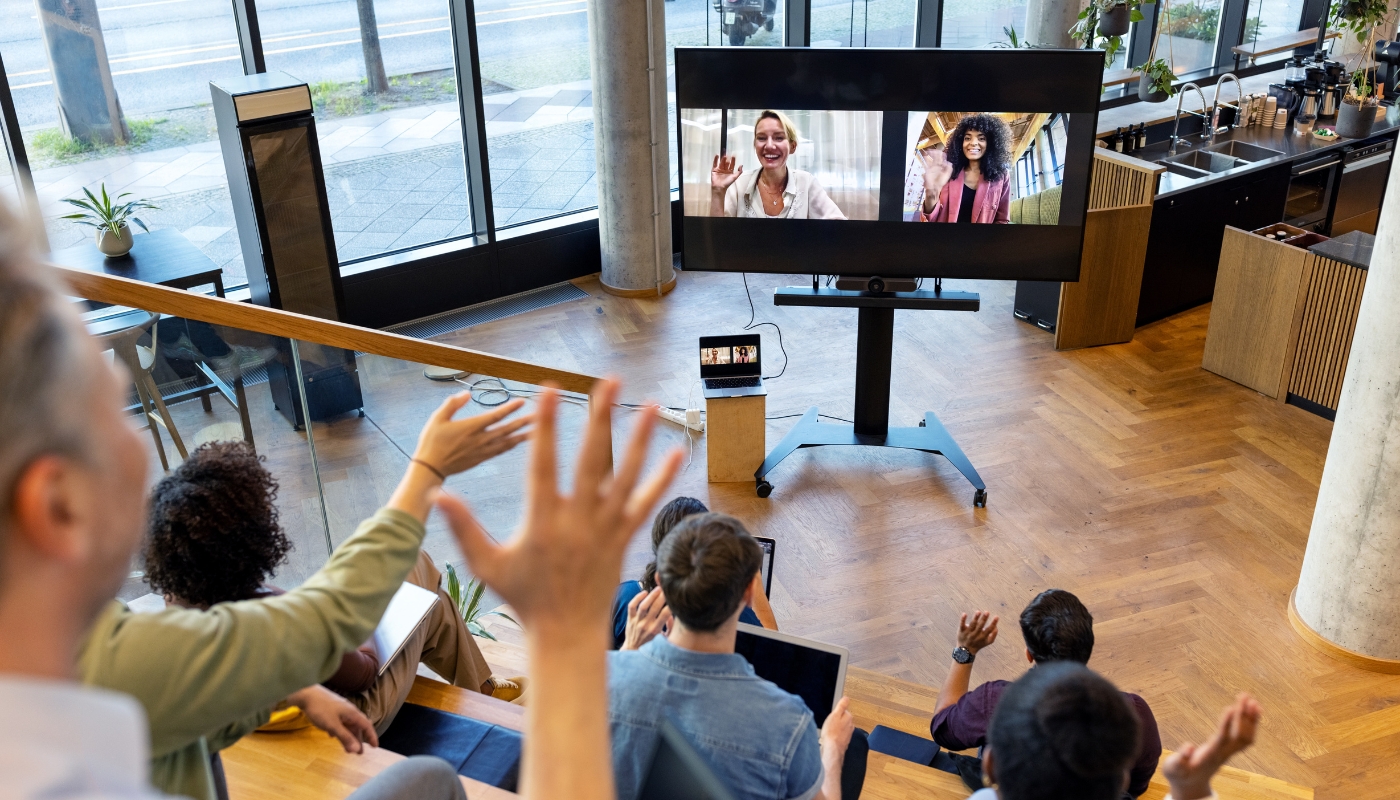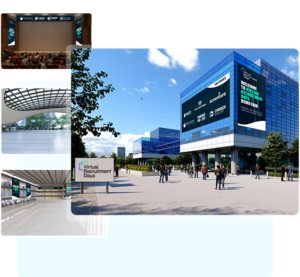Imagine hosting an event that transcends borders, time zones, and physical limitations. That’s exactly what hybrid events make possible. By merging in-person interaction with the reach of digital technology, hybrid events have redefined how we connect, collaborate, and communicate in a global world.
Whether you’re planning a conference, seminar, or product launch, hybrid events give you the flexibility to engage audiences anywhere – without compromising the experience. But what really makes a hybrid event successful?
Keep reading to discover how to design impactful hybrid experiences that captivate both live and virtual audiences – and future-proof your event strategy.
What is a Hybrid Event?
A hybrid event combines a physical gathering with a digital experience. This means that some attendees are present at a physical venue, while others participate online through a virtual platform. In recent years, hybrid events have surged in popularity, driven by advances in technology and evolving participant expectations.
A successful hybrid event ensures that both in-person and virtual audiences receive an engaging and valuable experience. It’s not just about placing a camera in the back of the room – it’s about creating interactive opportunities for all participants, wherever they are. These could include live chats, virtual networking lounges, polls, Q&A sessions, and one-on-one meeting booking – all seamlessly integrated with the physical event.
Hybrid events are especially effective for conferences, seminars, trade shows, trainings, and corporate meetings aiming to reach a broader audience without geographical limitations.
Pros and Cons of Hybrid Events
Benefits of Hybrid Events
- Wider reach
With both physical and digital attendance options, you can attract a much larger audience – globally without need for travel.
- Flexibility for attendees
Participants can choose the format that suits their schedule, location, and preferences.
- Higher ROI
Hybrid formats allow you to repurpose content, sell access to recorded sessions, and extend the life of the event.
- More data and insights
Virtual platforms provide valuable analytics on attendee behavior, engagement, and content preferences for future events and marketing.
Challenges of Hybrid Events – and How to Solve Them
- Unequal experience between in-person and online attendees
Digital participants may feel like passive viewers.
Solution: Use interactive tools such as live polls, Q&As, and joint workshops. Assign a dedicated virtual moderator to engage the remote audience.
- Technical issues and reliance on stable internet
Streaming or interactive features can be disrupted.
Solution: Ensure reliable, redundant connectivity, run full tech rehearsals, and have technical support available both on-site and online.
- Networking barriers between audiences
In-person attendees mingle naturally, while virtual participants may feel isolated.
Solution: Choose an event platform with virtual networking tools such as matchmaking, video calls, chat functions and break-out-rooms.
- Increased planning demands and dual production needs
You’ll need resources for both physical and digital production.
Solution: Design your hybrid format from the start, not as an afterthought. Use an event management platform that supports both formats seamlessly.

How to Plan a Hybrid Event
- Start with goals and audiences
Define your purpose: brand building, lead generation, internal engagement? Understand your in-person vs. online audience – and tailor the experience for both.
- Create a clear, flexible agenda
Hybrid events require structured yet dynamic programming. Keep sessions short, interactive, and varied. Plan transitions carefully so everyone can follow along.
- Choose the right platform early
Your platform should support livestreaming, interaction, attendee management, and networking. Integrating technology early ensures a smooth experience.
- Design for engagement
Build interactivity into the agenda – polls, Q&As, breakout groups, and digital meeting areas. Include both audiences in the conversation.
- Define roles and responsibilities
Assign moderators, tech leads, support staff, content creators, and communicators. A unified team ensures smooth delivery.
- Plan the entire attendee journey
From invitations to post-event follow-up – guide your audience every step of the way. Make logging in, navigating, and participating effortless.
- Analyze and improve
Use platform analytics to understand attendee behavior. Track engagement, drop-off points, and popular sessions to improve future hybrid events.
Common Mistakes in Hybrid Events
- Planning for one audience only
Don’t treat hybrid events like physical events with a webcam. This alienates digital attendees.
Fix: Develop content and engagement strategies for both in-person and online participants.
- Lack of tech preparation
Poor audio, frozen screens, and delayed streams damage your reputation.
Fix: Rehearse thoroughly. Test everything: internet, cameras, microphones, platform functionality.
- Forgetting the virtual audience
It’s easy to focus on the physical room and ignore remote attendees.
Fix: Appoint a virtual host to welcome online attendees and voice their questions during live sessions.
- Unclear pre-event communication
Confused attendees are disengaged attendees.
Fix: Send clear login info, program schedules, and participation instructions well in advance.
- No networking opportunities
Many attend events to build connections – don’t leave this out for online attendees.
Fix: Offer virtual lounges, breakout sessions, and matchmaking tools.
- No post-event follow-up
Valuable insights and relationships are lost if you go silent after the event.
Fix: Send thank-you emails, surveys, and recordings. Analyze feedback and data to improve next time.

The Future of Hybrid Events – Trends to Watch
- Personalized experiences
Attendees expect content tailored to their roles, interests, and past behavior – via AI-powered recommendations and customized agendas.
- Deeper interactivity
Gamification, audience-controlled content, and immersive experiences are replacing passive viewing.
- Fluid physical-digital transitions
Tomorrow’s platforms will let attendees move between formats – in-person one day, virtual the next – without losing the experience.
- Sustainability in focus
Hybrid formats reduce travel and emissions. Future events will highlight sustainability in practice and communication.
- Advanced analytics
The goal is no longer just to measure attendance – it’s to understand why certain elements worked. Platforms now offer tools for deeper insight into engagement, networking, and conversions. - Hybrid as the new normal
Hybrid events are no longer the exception – they’re the expectation. Flexibility and scalability in both content and technology are essential.
Measuring Success in Hybrid Events
Success is about more than just headcount. Look at:
- Engagement (chat participation, questions asked, poll responses)
- Feedback (post-event surveys, ratings)
- Business outcomes (leads, conversions, relationship-building)
- Platform analytics (session views, time spent, drop-off points)
Combining quantitative data with qualitative insights gives you a 360° view of your event’s impact. With the right platform, collecting and interpreting this data is easy – and game-changing for your future planning.
Case Study: BETT London – Creating a World-Class Hybrid Event
When BETT London opened its doors, Qualified Tutor didn’t just want to exhibit – they wanted to stand out and engage a global audience. In partnership with Virtualdays, they created a truly immersive hybrid experience.
A Digital Twin
They built a virtual 3D replica of the ExCeL venue, allowing remote participants to explore booths, attend livestreams, and network – just like in person, but from anywhere.
Personalized Experiences with AI
Using AI-based matchmaking, attendees received tailored content, session recommendations, and networking suggestions – all based on their interests and roles.
Borderless Networking
From virtual lounges to video calls and live chats, participants connected across the globe – whether onsite or online. This hybrid setup fostered a strong sense of community.
Long-Lasting Business Value
Beyond the event itself, the hybrid format drove long-term results: increased brand visibility, new leads, and stronger audience relationships.
Conclusion: Hybrid as a Strategic Advantage
BETT London proves that hybrid events aren’t just fallback options – they’re strategic opportunities. By blending physical presence with digital innovation, you can create powerful, personal, and scalable experiences.

Summary: Hybrid Events
Hybrid events seamlessly blend in-person and virtual experiences, allowing attendees to participate either on-site or online. This event format offers greater reach, increased flexibility, and valuable data insights – making it a powerful strategy for engaging diverse audiences regardless of location.
To run a successful hybrid event, organizers must:
- Deliver engaging experiences for both physical and virtual attendees
- Choose the right technology platform early in the planning process
- Design the entire attendee journey – from invitation to follow-up
- Avoid common pitfalls like poor communication, technical issues, and neglecting the virtual audience
The future of hybrid events lies in personalization, interactivity, and sustainability. When done right, hybrid events go beyond being a backup option – they become a strategic tool for creating scalable, inclusive, and high-impact experiences.
Are you ready to start planning your hybrid event? Book a personal demo now!






